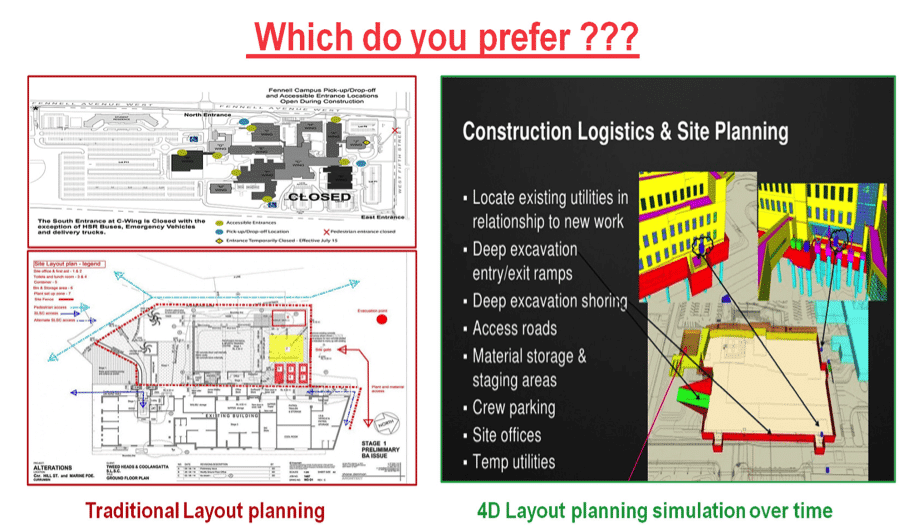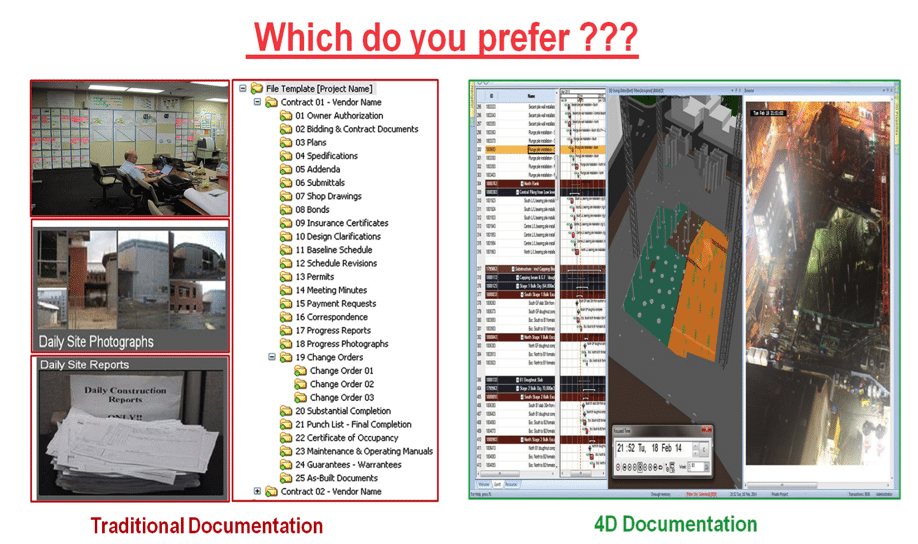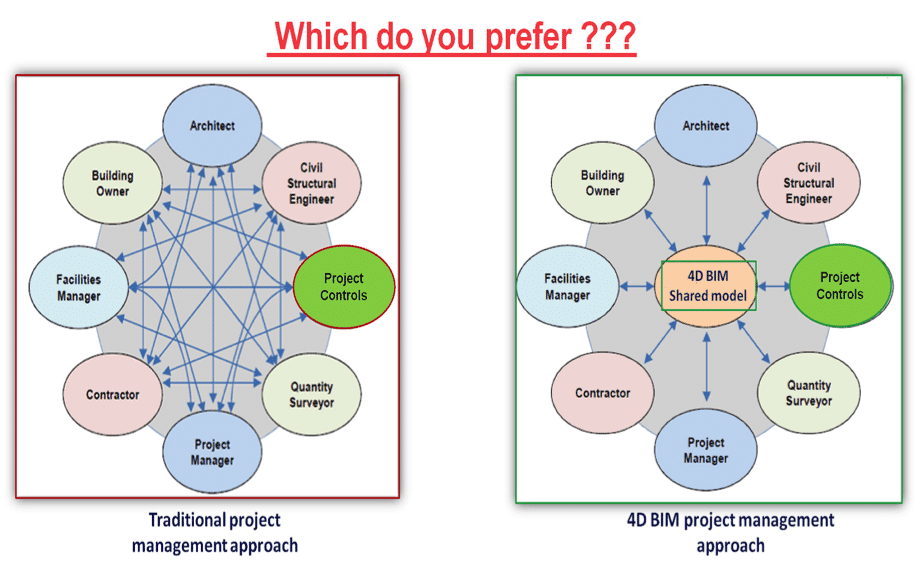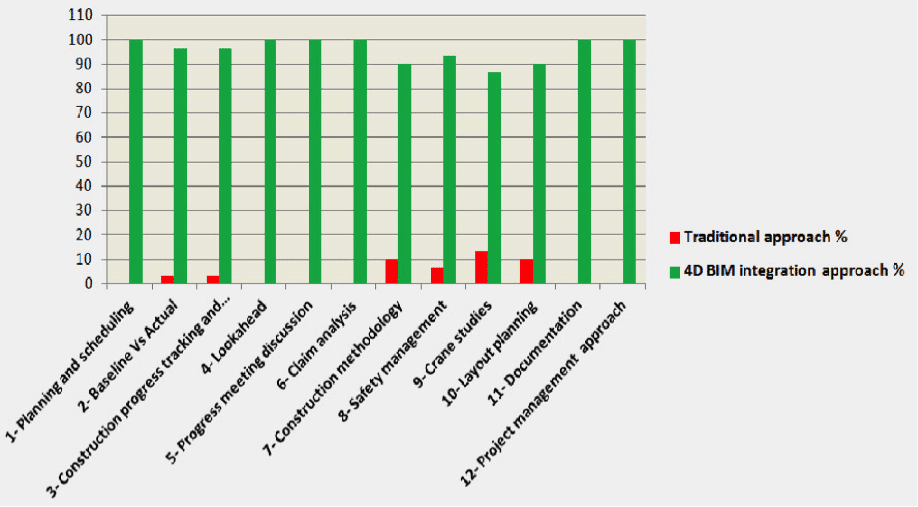“The 4D Scheduling/4D BIM is a useless technique. It doesn’t add any benefits to Project Controls. Its main purpose is to visualize the construction schedule, resulting in extra fancy requirements which we can survive without”.
From my point of view, I always get confused when I hear these phrases and I really don’t understand how/why professionals judge the 4D scheduling in this way. I wonder what their source of information about the 4D scheduling comes from.
In every BIM debate/discussion, there is someone who talks about how the traditional way of scheduling still could be better than the 4D scheduling. Some argue how easy it is to create the 4D model by simply linking each 3D element with the relevant task in the schedule and having a simple useless video.
Sometimes I understand his fear to move from the traditional scheduling to a new 4D scheduling environment. It might feel out of comfort zone or resistance to change. Some may consider the 4D scheduling as rocket science, while in fact, it is much easier and useful than the traditional ways.
Since the 4D is about visualization, I will set in this post the main benefits of the 4D scheduling and compare it visually to the traditional scheduling approach using charts and visuals only.
1. Planning and Scheduling
Traditional Scheduling: Only 2D schedule and bar chart.
4D Scheduling: Link your schedule to the 3D model, for a better understanding of the project.

2. Baseline vs. Actual Analysis
Traditional Scheduling: Bar-chart comparison in min 25 A3 pages.
4D Scheduling: Visual comparisons in 2 minutes video.

3. Construction Progress Tracking and Control
Traditional Scheduling: Inaccurate layout coloring and progress representation.
4D Scheduling: Export the 4D model to your iPad, go to the site, update it, go back to the office, link it to the PC and automatically update your progress.

4. Look-ahead Plan
Traditional Scheduling: Hard to follow look-ahead presentation
4D Scheduling: Very clear and visual look-ahead presentation

5. Progress Meeting Discussions
Traditional Scheduling: Taking time to explain problems or make a decision.
4D Scheduling: Very easy to visualize the problem, propose solutions, and solve make decisions.

6. Claim Analysis And Dispute Resolution
Traditional Scheduling: Very hard and time-consuming process to prove who is responsible for the delay.
4D Scheduling: Very easy to prove who is responsible for the delay and what is the expected outcomes in the future by using a video.

7. Construction Methodology Studies And Representation
Traditional Scheduling: Representing the construction methodology in a large number of pages.
4D Scheduling: Representing the construction methodology in a 2 minutes video.

8. Safety Management And Planning
Traditional Scheduling: So many documents and complicated plans
4D Scheduling: 2-minutes video representing the hazards and the safety plan visually.

9. Crane Safety And Location Studies
Traditional Scheduling: Complicated layouts
4D Scheduling: 2 minutes video representing all you need about the crane safety

10. Layout Planning And Management
Traditional Scheduling: So many layouts
4D Scheduling: 2 minutes video representing the dynamic layout and access roads

11. Construction Project Documentation
Traditional Scheduling: Many documents that require extensive data storage
4D Scheduling: One 4D model file that could save the schedule, 3D model, notes, and pictures.

12. General Project Management Approach
Traditional Scheduling: Can you imagine the number of mistakes, duplications, data lose, and time in analyzing the layout and documents?
4D Scheduling: One integrated shared model that everyone understands in the project.

Now with this visual comparison, which one do you prefer? 4D scheduling, or traditional scheduling?
4D Scheduling Survey
I conducted a survey in one of my 4D BIM seminars on Heriot-Watt University Dubai. This survey was completed by 30 master’s degree students with various engineering backgrounds ( Civil – Arch – QS – Mep ) and the results were impressive. Here is the summary of the survey:

As a result, 96% voted for the 4D scheduling while 3.8% voted for the traditional approach. What is most impressive is that 6 out of 12 comparison attributes voted 100% to the 4D scheduling and ZERO to traditional scheduling.

I have not included other factors in this comparison such as the initial cost of implementing the 4D scheduling, but based on my years of experience in 4D implementation, I assure you that the benefits of 4D scheduling way exceed the traditional scheduling methods.
I believe the 4D scheduling will be the standard of planning and scheduling in the near future, as we started to see some projects with mandatory contractual requirements for the 4D simulation. Also, I have been involved in many claims where that 4D simulation was part of the case submission.
Please share your thoughts on the subject below. Which one do you prefer; 4D scheduling or traditional scheduling? What challenges do you perceive for implementing 4D scheduling in your projects?
If you liked this post, please give it thumbs up and share it with your connections. Let’s together increase the awareness of 4D scheduling and the benefits that this approach can bring to our future projects.
About the Author, Tamer Elgohari

Construction Innovation – Senior VDC Engineer (4D/5D BIM)
Tamer is a senior Virtual Design and Construction (VDC) Engineer with more than 9 years of practical experience in construction management, innovation, BIM and construction visualization.
He is specialized in the 4D/ 5D simulation, construction project management solutions, integrated reporting systems, and innovation management.
Currently, he is working as the VDC and innovation manager for Analytica Management Solution, an integrated construction group that is best known for delivering turnkey special projects in the UAE.
He was responsible for the Virtual Design and Construction (VDC) implementation in various projects and locations including UAE, Egypt, GCC, and North Africa.
Tamer is the 4D BIM section editor for BIM Arabia Magazine. He also has many publications in the field of 4D BIM and presented at many digital construction conferences around the world.
Learn more Tamer or connect with him via his LinkedIn profile.





![[Free 90-min Masterclass] The Ultimate Leadership Recipe for Project Professionals](https://www.projectcontrolacademy.com/wp-content/uploads/2024/08/4-1024x576.jpg)















